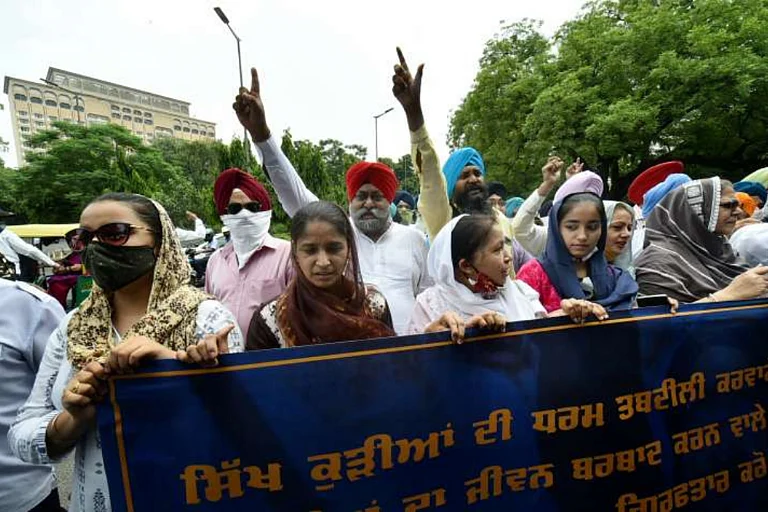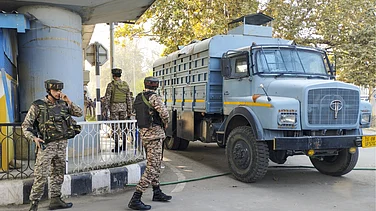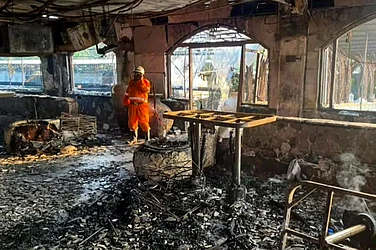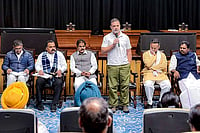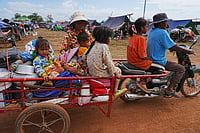
Between August 25 and September 3, 2025, unprecedented floods and cloudbursts ravaged northern India.
In Punjab, more than 40 people died, nearly 2,000 villages were submerged, over 350,000 people were affected, and 1.75 lakh hectares of crops were destroyed.
Rebuilding Punjab, however, will be a long and multi-phase process, extending far beyond clearing floodwaters.
India’s Northwestern border state and agricultural heartland, Punjab, carries a history both glorious and tragic. The Partition of 1947 divided not just its people but its rivers too. These rivers, once sources of abundance, turned fierce, flooding vast stretches of the land. Yet, the region born of these very rivers stood resilient. It emerged as a beacon of grassroots resilience, where community solidarity often outpaced official aid.
Between August 25 and September 3, 2025, unprecedented floods and cloudbursts struck northern India. In this brief yet devastating period, Punjab alone saw more than 40 lives lost, nearly 2,000 villages submerged, over 350,000 people affected, and 1.75 lakh hectares of crops destroyed.
While other northern states, including my own Jammu & Kashmir, awaited official aid during these days, Punjab was already responding. The story of resilience that unfolded was not shaped by government offices but by actions across submerged fields and winding village lanes in the immediate aftermath of the floods.
During the initial days, the official response was sluggish. No relief camps were established in the early days, leaving communities to fend for themselves. Yet the people of Punjab acted. Guided by centuries-old Sikh principles of Chardi Kala, unwavering optimism in adversity, and Sarbat Da Bhalla, the well-being of all, they launched spontaneous relief efforts that soon became a model of grassroots crisis response.
Punjab demonstrates that when institutions falter, community spirit leads in rebuilding and recovery.
Rebuilding Punjab, however, will be a long, multi-phase process that begins with clearing floodwaters and continues through careful damage assessment, rehabilitation, de-silting, restoration of fertile land, fogging drives, and implementation of long-term flood mitigation strategies. As experts warn, once floodwaters recede, stagnant pools may trigger epidemics such as cholera, dengue, and leptospirosis.
Despite being India’s agricultural heartland, Punjab still lacks a comprehensive crop insurance scheme, leaving farmers exposed to the full brunt of such disasters. One of the most urgent challenges now lies in the scientific and safe disposal of animal carcasses to prevent secondary health crises.
Youth-Led Initiatives: The Vanguard of Relief Efforts
As floodwaters engulfed Punjab, swallowing farmlands, homes, and roads, Punjab’s youth became the first responders. Volunteers and NGOs mobilised rapidly, coordinating despite working independently. Farmers turned tractors and trolleys into lifelines, navigating waist-deep waters to rescue stranded families and deliver supplies. NGOs partnered with local youth to run medical camps, deploy rescue boats, and distribute food, stepping in where official aid lagged.
Global Sikhs, partnering with the Saanjh Foundation, led immediate aid and longer-term rehabilitation. Damanjeet Kaur, volunteer, Global Sikhs, recalled the determination of youth volunteers who “were active from day one, focusing not just on rescue and relief, but prioritising urgent medical needs, especially providing sanitary pads and medicines for women and children, to contain the spread of waterborne diseases”. She further added that “It was clear the initial relief and rescue operations were spearheaded by the people, while official intervention came much later”
Global Sikhs founder Amarpreet Singh and trustee Gagandeep Singh outlined the challenges ahead: “As floodwaters recede, rebuilding Punjab requires careful damage assessment, rehabilitation, clearing sand from fields, targeted fogging to prevent disease, and planning long-term flood solutions.” He said phase two of relief is underway in Gurdaspur: pumping stagnant water, clearing debris, distributing cattle and livestock, rebuilding homes, and supporting agricultural recovery.
In rural Punjab, cattle are more than livestock — they represent family, livelihood, identity, and dignity. When Amrik Singh lost everything to the floods, a cow donated by Global Sikhs became his bridge back to hope — a symbol that life, like the land, can be renewed with compassion.
In Ajnala, families are receiving essential home appliances to rebuild their homes with warmth and grace, while in Fazilka, fogging drives continue to protect communities from post-flood diseases.
Under its Rebuild Punjab initiative, Global Sikhs has moved beyond immediate relief to long-term resilience. To ensure every home stands stronger and safer, Global Sikhs has brought together a distinguished panel of experts, architects, engineers, and community development specialists to guide the process. The panel includes UNESCO-awarded conservationist Ar. Gurmeet Sangha Rai, structural engineer. Mehul Shah, disaster recovery leader, Manu Gupta (SEEDS), historian and community specialist Yaaminey Mubayi, and ecological designer Ar. Akshay Kaul, and regenerative systems expert Clea Chandmal. Together, they represent the vision behind Phase 2, Rebuilding Roots, Restoring Lives, a people-centred model of recovery where heritage, sustainability, and dignity become the foundation of Punjab’s rebirth.
Water Warriors Punjab, led by Prof. Manjeet Singh, joined hands with local students and activists to organise clean-up drives. Harpuneet Kaur, from Water Warriors, said, “I couldn’t stand by while my community suffered. We connected with other students and formed a relief team immediately.
There are countless local organisations whose strength lies in understanding local demography and mobilising resources at the local level, working within their areas to resurrect Punjab. One of them is Lokwelfare working in Gurdaspur.
Several other prominent organisations are tirelessly working on the ground, including Khalsa Aid, Round-glass foundation, United Sikhs, Vatrukh, Initiators of Change, and Hemkunt Foundation.
These organisations were born in Punjab with a mission to serve the world, and today, they stand resolute, channelling their strength and compassion to provide relief and aid to their own people in this time of dire need.
Stories that Stood Out:
Karanjot Singh, 21, from Ludhiana, who lives with polio, joined relief efforts and helped build embankments.
Near Amritsar, an elderly father whose home was submerged offered tea to the rescuers - a small gesture that spoke volumes of the Spirit of Chardi Kala.
Farmers in Sasrali village built temporary barriers to shield their homes from the swelling Satluj River.
Perhaps the most inspiring aspect of the relief efforts is the fearless leadership of Punjab’s women. From wading through knee-deep waters to lifting heavy sandbags to constructing emergency embankments, they stepped forward to rebuild their homeland.
Solidarity on the ground was striking. Artists, business owners, farmers, the Indian Army and local officials joined youth volunteers. Many left their own families to serve those affected.
Animals caught in the floods also received care and shelter. Punjab’s response is more than survival; it shows how empathy, solidarity and collective action can turn despair into hope.
Disaster or Negligence?
The catastrophic floods were not solely natural; human mismanagement exacerbated the crisis. Despite early warnings from the India Meteorological Department (IMD) and the Bhakra Beas Management Board (BBMB) about above-normal rainfall and rising dam levels, critical actions were delayed. Bhakra Dam, which had reached over 70 per cent capacity by late July, continued to store water instead of releasing it in a controlled manner. Spillway gates were opened only on August 19, coinciding with peak flood conditions downstream.
This underscores the need for proactive disaster management. Reactive measures are no longer enough; transparent decision-making, timely action, and community involvement are essential.
Until recently, climate disasters were considered rare; today, however, they have become an unsettling reality. Punjab’s experience underscores the urgent need for long-term policy frameworks—moving from prior approaches to integrated solutions: integrating climate risk into urban planning, agriculture, and river management, restoring wetlands, reforesting catchment areas, enforcing the tree preservation act, and strengthening community-level preparedness.
A Global Lesson in Climate Crisis Response
Punjab’s grassroots resilience is more than a local story; it offers a scalable blueprint for a world battered by climate extremes. It proves that when formal institutions falter, shared responsibility, rooted in solidarity, empathy, and local knowledge, becomes the first line of defence.
From floods in Southeast Asia to hurricanes in America, governments often struggle to respond swiftly. Punjab proves that empowering local communities and nurturing volunteer networks can not only save lives but also minimise long-term destruction. Let us encourage policymakers and citizens across the globe to prioritise investment in local resilience and community-led preparedness now, before the next disaster strikes.
As the climate crisis deepens and the fragile ecology of the Himalayas has been disrupted, the world must heed Punjab’s example: integrate sustainable resilience, local wisdom, social solidarity, and proactive policy into climate crisis frameworks.
Kanwal Singh is a Policy Analyst and columnist from J&K .









